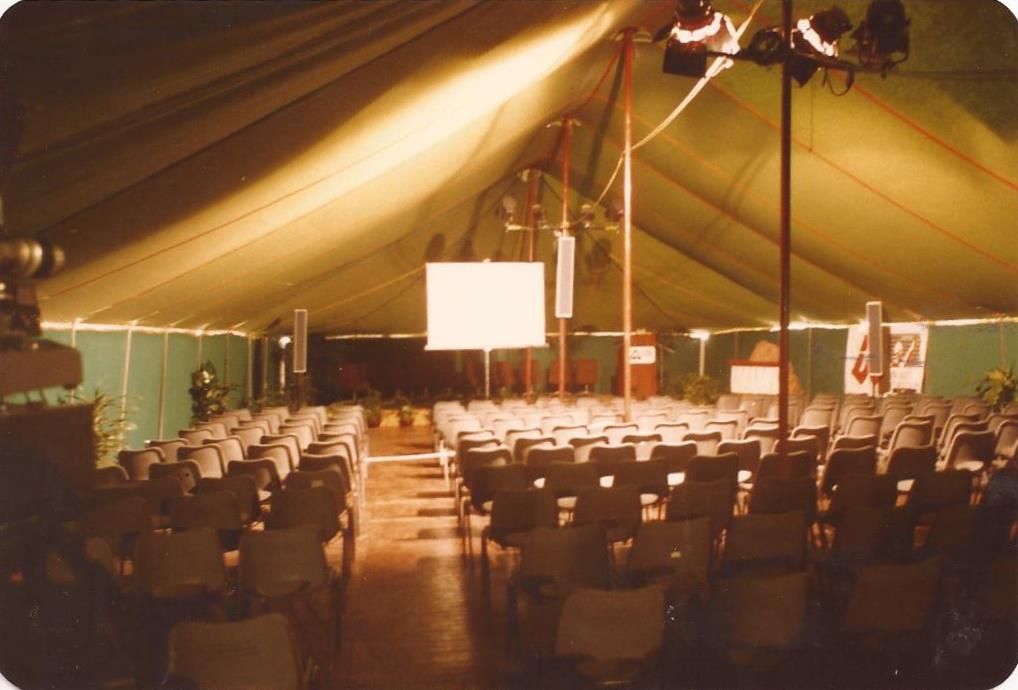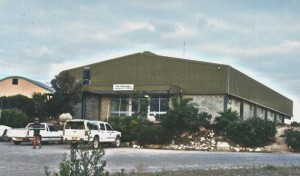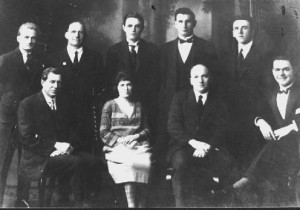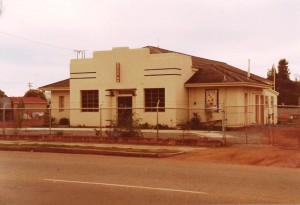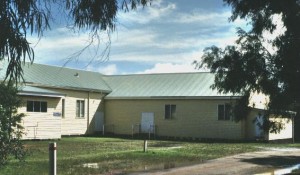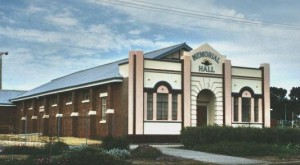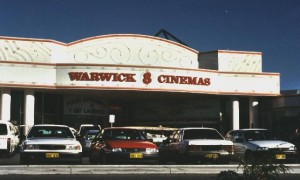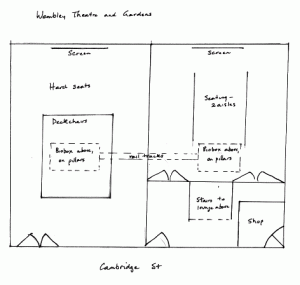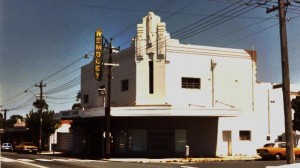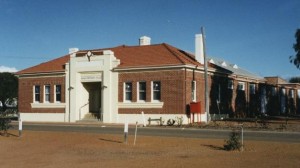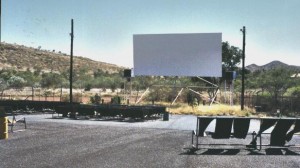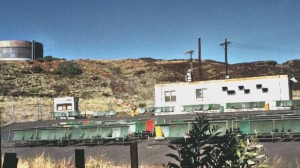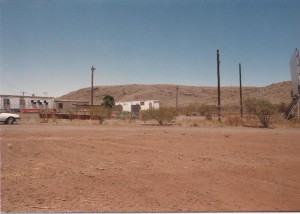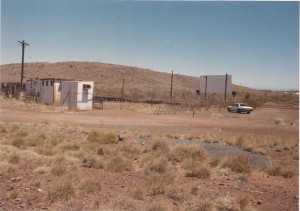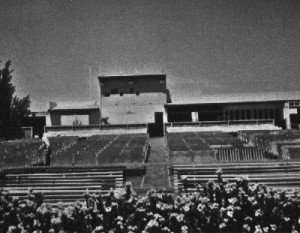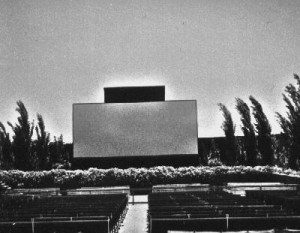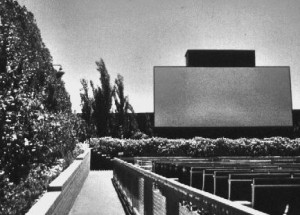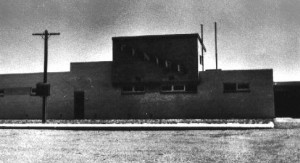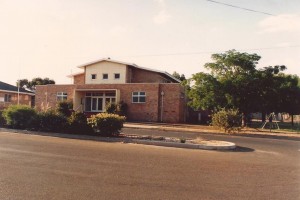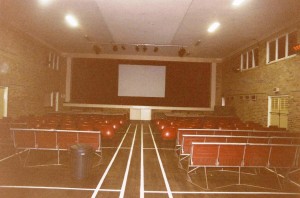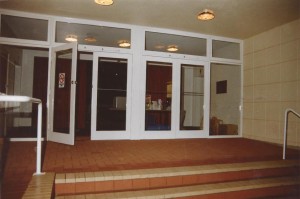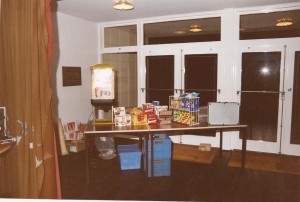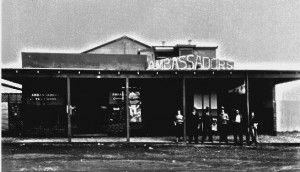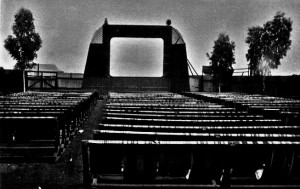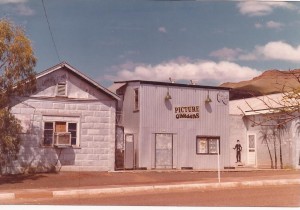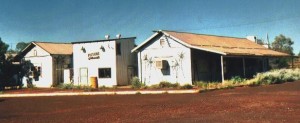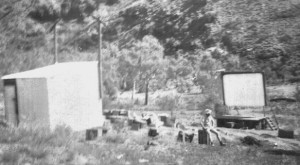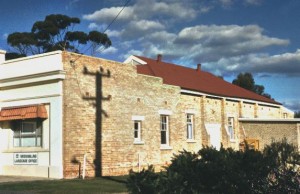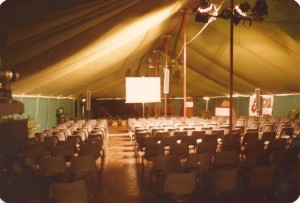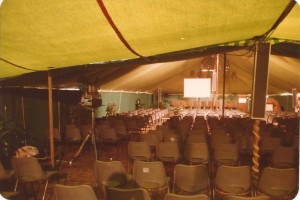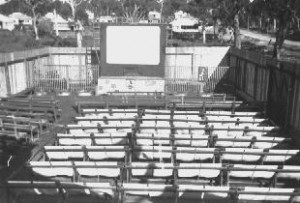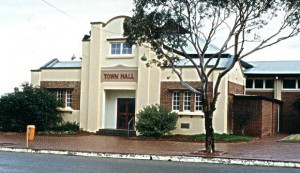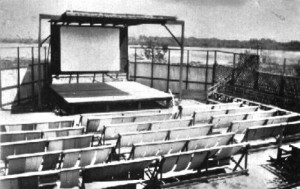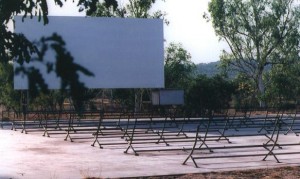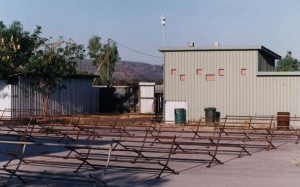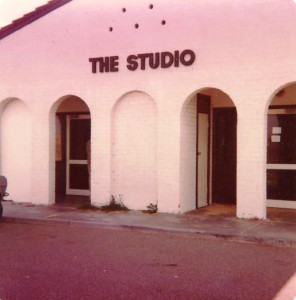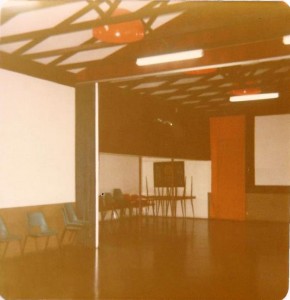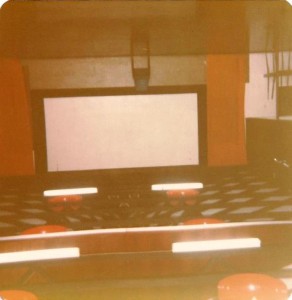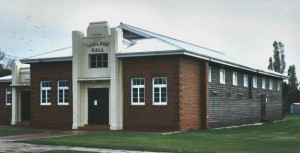Quicklinks
USELESS LOOP
RAY BENGOUGH HALL, Useless Loop
- Ray Bengough Hall 1997
The town of Useless Loop was built to serve the Shark Bay Salt Joint Venture on Heirrisson Prong. As a company town, it had film screenings provided as part of the amenities the company offered its workers. At first these were Friday night screenings in 16mm, in the old community hall, run by Barry Beeson, the electrical contractor. Then the Ray Bengough Hall was built, opening on 9 April 1988. This is a large concrete brick structure with a colorbond roof, unlined, and with a floor designed for indoor sports such as badminton and basketball. Portable plastic chairs are put out when a film is to be screened, and the screen pulled down like a blind.
At first, 16mm films were provided in this hall too, but, as these had to be hired with the projector each time, the company decided to try video projection as a cheaper alternative. This began about a year after the opening of the new hall, and has continued ever since. A ´G’ or ´PG’ film is provided every Friday night, to a usually young audience, whose parents are often relaxing at the bar in the mess next door. A more adult film is screened once every three weeks on a Sunday night.
Sources: Informants: Roseanne Murray (Useless Loop 1997), Steve Holmes (Useless Loop 1997)
Photo: 1 exterior, colour, 1997, Graeme Bertrand
VICTORIA PARK
AMUSU THEATRE, 443 Albany Rd (now Albany Hwy), Victoria Park
This was the first purpose-built cinema in the suburb, and the smallest of the three cinemas owned by J.R.Johnson. The theatre opened in 1922 on the south side of Albany Rd, in the middle of the block between McMillan and Temple Sts, opposite the old police station. As it was built so early, in the days of small silent projectors, the bio-box was small too and accessed up a stairway from the foyer. Alan Crew remembers that two machines filled it, and 2000 ft spools were a great relief – otherwise it was a mad-house on a ten-minute reel change: ´fortunately I was a skinny little cow anyway’. As the other Victoria Park theatres came into use, the Amusu was used less often, as a back-up theatre for either the Amusu gardens or the other two hard-tops. It was also used sometimes for roller-skating.
The Amusu Gardens opened soon after the hard-top. It was behind the theatre, running across the block to Temple St and with access along a laneway beside the theatre. It was larger than the hard-top and had a separate bio-box, and by the thirties was used much more than the Amusu theatre.
In 1928 the Amusu theatre and gardens was one of only four venues in the suburban area screening every week-night, but in the slump the following year ´Cinema Cabaret’ was introduced, which allowed patrons to dance in a dim light while the picture show continued. Both the theatre and gardens were purchased by Goldfields Pictures in 1946 with the rest of the circuit, but never operated as a cinema by them. The site was almost immediately sold to a developer who demolished the building and built shops.
Sources: Max Bell, Perth – a cinema history, The Book Guild, Lewes, Sussex, 1986, pp.19, 55
Everyone’s, 8 February 1928, p.27; 16 January 1929, p.24; 13 November 1929, p.24
Post Office Directory, 1922 – 1947
West Australian, 1932 – 1940 24 January 1964
Photos: 1 Amusu Theatre staff [back row L to R – Eric Scholl (violin), Jack Burgess (doorman), Harry Orkney (piano & conductor), Harry Johnson (cornet), Jack Johnson (doorman), front row L to R – George Hall (Partner & operator), Miss Hall (ticket seller), Jim Johnson (partner & manager), Norm Cunningham (publicity manager)]; b&w, 1923 (Norman Cunningham)
BROADWAY/NEW BROADWAY AND GARDENS, 330 Albany Rd, Victoria Park
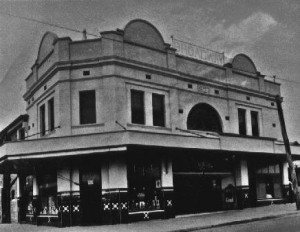
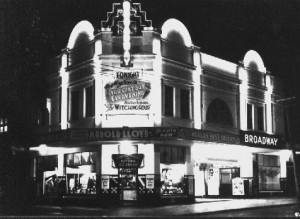
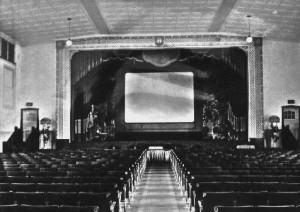
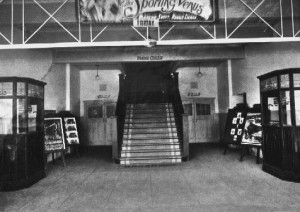
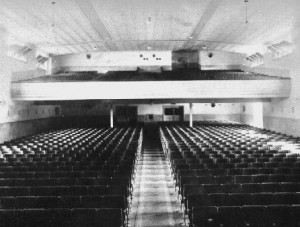
The Broadway was built on the southern corner of the intersection of Harper St and Albany Rd (now Albany Hwy). Shortly after it was built in 1927, this 1200-seat cinema was taken over by J.R.Johnson, who then controlled all three cinemas in Victoria Park. The design was identical with the Premier, East Perth – a rather more showy and spacious building than the average suburban cinema: Alan Crew remembers the pressed-metal ceiling, the blue curtains, and plaster baskets on each side of the proscenium with artificial flowers which were not changed for a very long time. It had a lesser hall, where Johnson lived with his wife, entering through a separate stairway next to the theatre.
In 1939 it was closed for a short time for alterations designed by architect Bill Bennett, and re-opened as the New Broadway. The roof structure was completely altered: the Johnsons moved out of the lesser hall, which made way for an extension of both the stalls and dress circle, and the bio-box, which had been just above the old stairway to the circle, was re-located. The new bio-box was large and had good sightlines, but by a miscalculation patrons in the rear row of the circle would have walked through the lightbeam, so the projectors were built up on a foot of concrete to lift the beam: this created problems for the projectionist, both in threading the machines, and in changing the carbon, which could only be done by standing on the concrete to reach in.
The Broadway did not at first have a gardens, as Johnson did not like the concept of open-air screenings, however, in 1948 the venue became part of the Goldfields Theatres chain, and a gardens was added, about 1951, behind the theatre. When the venue closed in 1964 the theatre building was converted into a supermarket.
Sources: Max Bell, Perth – a cinema history, The Book Guild, Lewes, Sussex, p.62
Everyone’s, 12 February 1930, p.25
Film Weekly Directory, 1943/4 – 1963/4
Post Office Director, 1927 – 1949
Victoria Park Movie Magazine
West Australian, 1927 – 1964, 24 January 1964
Interview (Ina Bertrand/Bill Turner): Norman Cunningham (1981)
Interview (Ina Bertrand): Alan Crew (1997)
Photos: 2 exterior, b&w, 1928/1937 (Graham Norton)
3 interior, b&w, 1928 (Graham Norton)
1 exterior, colour, 1981 (Bill Turner)
SAVOY THEATRE AND GARDENS, 830 Albany Rd, Victoria Park
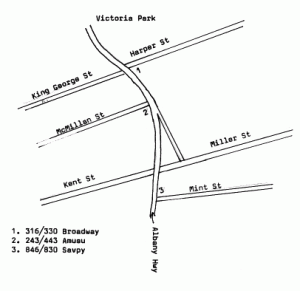

This solid red-brick building holding approximately 900 patrons was built on the south-east corner of Mint St and Albany Rd (now Albany Highway). It was the second theatre to be built by Johnson in this suburb as part of his chain of three Victoria Park cinemas. Alan Crew remembers it as ´a lovely little place’, though at first the projectors were angled to almost fall through the front wall of the bio-box, as the screen was so close, apparently directly in front of the balcony.
Around the end of 1935, the building was altered: the back wall was pushed back to extend the auditorium a hundred feet, and the circle was also extended now that the screen was far enough away. It became a comfortable venue, with padded seats throughout, though carpeted only in the lounge and with no upstairs foyer. While Vic Basham was working there (around 1942-5), the equipment was upgraded to Raycophone CP7s, with XL-Tone sound heads and amplifiers made by Pidgeon and Denford’s electronics.
Like the Broadway, the Savoy was acquired by Goldfields Pictures in 1946, and a gardens added, about 1951, on the same side of Albany Rd but north of Mint St.
When the venue was sold in 1960, the theatre building was converted for use as a warehouse and store for Vox Adeon.
Sources: Max Bell, Perth – a cinema history, The Book Guild, Lewes, Sussex, pp.48, 66
Everyone’s, 16 January 1929, p.24
Film Weekly Directory, 1943/4 – 1960/61
Post Office Directory, 1930 – 1949
West Australian, 1934 – 1960, 7 February 1962
Interviews (Ina Bertrand): Vic Basham (1997), Alan Crew (1997), Ron Elsegood (1985)
Photos: 2 exterior, colour, 1981 (Bill Turner)
EAST VICTORIA PARK
CREMORNE GARDENS, Cnr Welshpool Rd and Albany Hwy, East Victoria Park
This beautifully-laid-out picture gardens was built by Goldfields Pictures in 1950, and was doing well, but the site was very valuable so they sold to developers in 1958.
Sources: West Australian, 1956 – 1959
Interview (Ina Bertrand): Ron Elsegood (1985)
WAGERUP
HALL, Wagerup
There may have been films screened in the Wagerup Hall in about 1950, by P.W.Hassell
Sources: Film Weekly Directory 1951/2
WAGIN
AGRICULTURAL HALL/ TOWN HALL, cnr Tudor and Tavistock Sts, Wagin
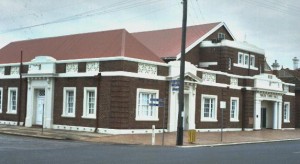
The Agricultural Hall was built in about 1896, and run by a local committee. It was probably in this hall that the various travelling showmen presented their wares, starting with the Salvation Army Biorama Company (September 1900, September 1902, February 1904) and Stevenson’s Royal Biograph, (January 1905). The Taits brought The Kelly Gang, complete with searchlight, in July 1907, and Robbery under arms the following year. In February 1908, the British and American Biograph visited the town and only a month later, the Musical All-Blacks and Page’s Supreme Pictures performed there. The Corricks stopped for one night in November 1909.
In February 1909 the hall trustees relinquished their rights to the Municipal Council. In the twenties, open air pictures were presented in summer on the vacant land next to the hall, and the hall was the venue in winter.
In 1927, plans for a new brick-fronted cinema were approved, but building did not proceed because of the construction of the new Town Hall that year, on the site of the former open air pictures: the Agricultural Hall became the Lesser Hall, and both were formally opened in 1929. Pictures were presented in the new Town Hall from at least 1928 to the early thirties by J.H. Wansborough as Town Hall Pictures. H.E.Lambert tried to run a show at Wagin during the depression also, for about one year, probably 1929-30, but had to pull out. In the forties the show was operated by F.S.Flood, who renamed the venue the Plaza in the late forties. Then from 1950 Paddy Baker’s circuit included the town, and he was screening in the Town Hall before being part of the consortium that built the drive-in. After that, films were no longer screened in the Town Hall.
Sources: Film Weekly Directory 1940/41 – 1964/5
Post Office Directory 1929-3/5, 1946-1949
Public Works Department, files 1926-56, Battye AN 7/10 AC 1004
Shire of Wagin, Wagin Heritage Trail
Max Bell, Perth – a cinema history, The Book Guild, Lews, Sussex, 1986, p.124
Max Bell, Kino, no.19, March 1987, p.10
M.J.Pederick, The emu’s watering place: a brief history of the Wagin district , Shire of Wagin/Churchlands College, 1979
Everyone’s 9 May 1928, p.34
Interview (Peter Morris): Paddy Baker (1978)
Interview (Ina Bertrand): Len Lambert (1997)
Limelight Picture Show Tours, http//:www.abc.net.au/limelight/docs/tours
Photo: 1 exterior, colour, 1997, Graeme Bertrand
LITTLE GEM THEATRE, Trent St, Wagin
In 1914, Wagin’s first electric power supply was turned on, operating from the power house on the north-east side of Trent St, between Tudhoe and Trimdon Sts. A larger building was constructed on the same site in the twenties, and survived a fire in the forties, with assistance for rebuilding coming from the SEC. In 1960 the power house ceased operation when the SEC took over provision of the power for the town.
Frank Terry arrived in Wagin in 1963 to run the drive-in for Pat Baker. When it closed in 1983, he tried to revert to pictures at the Town Hall, but it was too big. So he bought the old powerhouse – which since 1960 had been used by the SEC as a storeroom. It was a very appropriate use for the building, given both the frequent association of the powerhouse and the cinema in the very early days of film, and that the building has echoes of art nouveau in its facade. The lighted sign for ´Little Gem Theatre’ is placed vertically on the facade, like some of the earlier suburban cinemas.
Inside, it was set up with second-hand gear, including one hundred seats from the Theatre Royal: these were replaced ten years later with larger ones so in 1997 there were only 76 seats. The projectors were not brought across from the drive-in (they are still there), but were constructed out of other projection equipment, providing facilities for both 35mm and 16mm (including 16mm xenon).
The conversion of the building took eighteen months, with Frank Terry doing the metal work including the equipment, and Arthur Kersten on the timber side. The cinema opened in 1984, Friday and Saturday nights at first, then two additional nights, because some people in the town could not come on a weekend. It can fill on a weekend, particularly with a popular film: the best has been Babe, which ran twice a night for four nights and then more.
It is a cosy theatre, with comfortable seats, the walls draped and a rich red stage curtain. The ceiling has acoustic tiles, and the floor is carpeted. There is a tiny traditional foyer, and an old projector on display at the entrance to the theatre itself. The tradition of the Wurlitzer is suggested by the playing of a tape of Wilbur Kentwell as the show opens.
Some screenings are provided for local charities: they sell tickets and provide supper in the nearby CWA hall, and the money from the ticket sales is split. Occasionally a school will come in, particularly when there is a study guide on a film – but this does not happen often.
Frank Terry has theoretically retired: this is a hobby. But the small cinema has become a part of the social fabric of the town.
Sources: Shire of Wagin, Wagin Heritage Trail
Max Bell, ´New cinema opens in Wagin’, Kino, no.16, June 1986, p.23; no.19, March 1987, p.11
Informant: Frank Terry (1997)
Photo: 1 exterior, colour, 1997, Graeme Bertrand
1 exterior. colour, 2010, Max Bell
WAGIN DRIVE-IN, Ballagin St, Wagin
Paddy Baker was part of the consortium that built this drive-in at the northern edge of town, which was officially opened on 12 September 1963 and opened to the public the following night. It held 160 cars at first, but was soon extended to accommodate 240. Frank Terry arrived in Wagin in 1963 to manage the drive-in for the consortium: he later bought all the local shares, and finally he bought out Baker and owned it himself. It closed in 1983, and Terry built the Little Gem Theatre in the town.
In 1997, the drive-in site looked dilapidated but was still clearly recognisable as a drive-in: the brick entrance and gravel ramps and mesh fence were still in place, the brick bio-box/concession building and ticket box were still in reasonable repair.
Sources: Film Weekly Directory 1963/4 – 1971
Public Health Department, building permit, Battye 1459
Max Bell, Kino, no.19, p.10
Wagin Argus 5 September 1963, 12 September 1963
Interview (Peter Morris): Paddy Baker (1978)
Informant: Frank Terry (1997)
HALL, Walter Rd, Walkaway
In the first half of the century, Walkaway was a thriving farming town, producing mainly wool and wheat.
The Corricks visited there in October 1909, Jos. Connolly was registered as an exhibitor in 1931-1933/4, and Ray Dean’s circuit screened there weekly for a short while in the fifties. All these screenings took place in the community hall, originally built in 1901, and with a new porch added as a war memorial in 1920. It is a stone building, the ceiling lined with Swedish pine brought out on wool clippers as ballast. It has a beautiful sprung timber floor, and in earlier times had a stage built out into the hall, though there was never a built-in bio-box. The town’s first electricity supply came from a privately-owned generator, belonging to the family next door to the hall. The hall was used for all community activities, including both Anglican and Catholic church services, meetings of local organisations such as the CWA or Junior Farmers, dances and film screenings. Ray Dean remembers screening there occasionally in the early fifties.
It has been repaired in recent years for community use again – as a youth club, and occasionally for dances and other activities, but films have not been screened there for many years.
Sources: Film Weekly Directory 1950/51 – 1951/2
Post Office Directory 1931-1933/4
Interview (Ina Bertrand): Ray Dean (1997)
(check with Kath Criddle and Nancy Hammersley)
Photos: 1 interior, colour, 1997, Graeme Bertrand
1 exterior, colour, 1997, Graeme Bertrand
WALPOLE
WALPOLE HALL, Latham Ave/Pier St, Walpole
The first Walpole Hall was built in 1938 in Latham Ave. It was a small timber hall, and pictures were screened there almost immediately, once a week. Some children in early audiences, who had never seen moving pictures before, screamed when the MGM lion roared for the first time in Walpole. The first operator was Mr Olwin Phillips, employed by Joe Rourke of Kojonup: Phillips travelled from Denmark with the films on the Railway bus and returned the same way next morning. He arranged for local farmer/carpenter Phil Dawson to build a bio-box on the outside of the hall in 1946.
The hall had a flat floor so that it could be used for all community activities, and seated about a hundred people on rather uncomfortable wooden seats with wooden backs. There was no heating, so people took rugs and cushions. The audience was enthusiastic: some locals remember one middle-aged patron who laughed so loudly that he took viewers’ attention away from the film, and another lady who would call out to warn the hero when the villain was approaching.
After Joe Rourke, a Mr Barastinski (?) from Rocky Gully took over for a short while, then some members of the Walpole P&C ran the films – Claude Cooper, Bruce Burnside and Bob Byleveld.
The Shannon River settlement closed in 1971, and in 1978 their hall was transported to Walpole and set up in Pier St, as the town’s main hall. The old hall was then shifted round the corner from its first location to become the Lesser Hall, beside the new town hall. At this time, the bio-box was dismantled, and the new structure had no projection facilities, so no further films were screened there.
Sources: Max Bell, Perth – a cinema history, The Book Guild, Lewes, Sussex, 1986, p.124
Informants: Joe Burton snr (Walpole, September 1997), Norman Mills (1998), Mrs Rourke (Bullcreek 1997)
Photo: 1 exterior, colour, 1997, Graeme Bertrand
WANDERING
WANDERING SHIRE HALL, Watts St, Wandering
This hall was built on the south-east corner of the intersection of Watt and Down Sts. The foundation stone was laid on 9 September 1896, indicating that the architect was Howard Evans and the builder was Robert Turton. Describing the photograph in A.Schorer’s local history, the Municipal Inventory indicates what it looked like in the early period:
The building was originally built in fair-faced brickwork. The facade originally featured a central portico with a gable roof, and a semi-circular arched window either side. Timber fretwork decorated the front gable.
In 1996, it was described in the Heritage Inventory like this:
The building is rectangular in shape, and sited back from the building line. The rendered brick walls sit on a stone plinth. The building is approached by curved, concrete steps that are protected by a low wall of random rubble with dressed joints.
The exterior of the building features a circular accent in the gable wall, with a metal louvred vent. The side walls feature four, heavily recessed windows with awning sashes…
Alterations were made to the building in 1962, which is the date currently set above the door.
In the silent days, one of Paddy Baker’s circuits ended with Arthur Williams Wandering Home (i.e., stopping in the towns of Arthur River, Williams, and Wandering, then home to Perth).
After talkies arrived, Charlie Legg visited the town about once a month. He travelled on his own in a van, and brought his own screen. There was a bio-box built outside the back of the hall, so the projectionist could screen through holes cut in the back wall: access to the bio-box was up outside stairs (all this was removed when a kitchen and supper room were added at the back of the hall, long after Legg had stopped showing pictures). Patrons had to enter the front door, then come round or under the screen, that hung across the doorway, and blew in the wind. They sat on wooden forms, only some of which had backs. Some had their own chairs left permanently in the hall: two cane chairs were known as ´Mr and Mrs Charlton’s chairs’, and no-one else would sit in them. During the war years, Mrs Charlton sat in her own chair, knitting socks for the Red Cross all through the picture. Mr Penington and his wife would bring a wool bale to put their feet inside, and a rug for around their knees – because of the cold. The swallows nested in the hall, so it was wise to arrive while the lights were on so you could choose a seat where there was no evidence that a nasty surprise might be in store once the lights went out!
These screenings were held on Sunday night, and the Charlton children would beg their father to take them to school in Perth on Monday morning by car, so they could go to the pictures on Sunday night, even if it meant getting up very early, while the frost was still on the grass.
In 1949 Legg sold his circuit to Lew Punch, who continued to visit the town through the fifties.
Sources: Film Weekly Directory C.Legg circuit 1940/41-1948/9
Shire of Wandering,Municipal Inventory, site no.1
Interview (Peter Morris): Paddy Baker (1978)
Interview (Ina Bertrand): Charles Legg (1997)
Informant: June Woolfitt (Wandering, September 1997)
Correspondence with Judy Love, Mundaring & Hills Historical Society, 19 June 1997, including notes of interview with Lew PunchPhotos: 1 exterior, b&w, 1896?, A Schorer, The horses came first: a history of the District of Wandering , Service Printing COmpany Pty Ltd 1974, p.90
1 exterior, b&w, 1996, Shire of Wandering, Municipal Inventory, site no.1
1 exterior, colour, 1997, Graeme Bertrand
CENTENARY HALL AND GARDENS, Wanneroo Rd, Wanneroo
The first silent film shows in Wanneroo were held in the Agricultural Hall, which had been built some time before 1909. These screenings continued throughout the twenties, till in 1929, to mark the centenary of Western Australia, the Centenary Hall was built by private citizens. This was where regular screenings of sound films began in 1930, and these were so popular that the building was extended and a gardens accommodating 200 was added in 1958. The venue was operated first by H.J.Dennis, then by the Crisafulli family – first Antonio, then from 1947 his son Ned. It was closed in about 1966, and in 1969 the building was demolished to make way for extensions to the garage next door. By then, the town had a new Town Hall, designed by architect Margaret A. Feilman and Associates, costing £29,000 and opened on 17 July 1965, but films do not seem to have been screened there.
Sources: Max Bell, Perth – a cinema history, The Book Guild, Lewes, Sussex, 1986, p.22
Greg Daniel & Margaret Cockman, The story of Wanneroo, Shire of Wanneroo 1979
Film Weekly Directory, 1955/6 – 1964/5
Photo: 1 exterior, b&w, n.d., Greg Daniel & Margaret Cockman, The story of Wanneroo, Shire of Wanneroo 1979 (picture section not paginated)
MOONLINE DRIVE-IN THEATRE, Archer St, Wanneroo (now Pearsall)
One of the later drive-ins to be built was the Moonline, on ten acres of bush, just east of Wanneroo Rd. A strip of natural bush at least ten feet wide was left surrounding the ramp area. The site was lit by three huge lamps – the largest available at the time of building. Self-service catering facilities were designed to reduce waiting time. Otherwise, the new venue was very similar to earlier drive-ins. It opened on 27 September 1974, and was operated by City Theatres. In 1988, Hoyts took over City Theatres and immediately closed all six drive-ins: the Moonline was then sold for $350,000. The drive-in was demolished and the land was cleared for a housing estate.
Sources: Public Health Department, building permit, Battye 1459
Daily News, 26 September 1974, pp.23-26
Kino, no.25, September 1988, p.23
West Australian, 1974 – 1988
Interview (Ina Bertrand): Arthur Stiles (1985)
Photo: 1 exterior, b&w, 1974, Daily News, 26 September 1974, p.23
WAROONA
MEMORIAL HALL, South-west Highway, Waroona
The Memorial Hall was designed by architects Powell, Cameron and Chisholm in 1932. It opened on 4 December 1934 on the eastern side of the South Western Highway between Millar and Parnell Sts, in front of the showgrounds. It was of brick and stone construction, with a built-in bio-box and a corrugated iron roof.
Before the town was on the SEC power, Jack Madison, who was also manager of Waroona Electric Light Co, had the picture contract in the Memorial Hall for some years. In the forties, it was on the Kanzler circuit out of Albany, sold to Allan Jones of Busselton in 1949. Screenings ceased in the late sixties, but Roy Mudge of Perth screened there every second Friday from 8 November 1991 to 15 January 1994.
Sources: Film Weekly Directory 1940/41 – 1967/8
Architects drawings, Shire of Waroona
Laurie Snell, Drakesbrook Days and Waroona Years, Shire of Waroona 1986
Interview (Ina Bertrand): Roy Mudge (1997)
Photo: 1 exterior, colour, 1997, Graeme Bertrand
WARWICK
WARWICK 8, 639 Beach Rd, Warwick
The old Warwick Hotel (formerly owned by Abe Saffron) was demolished on the north-east corner of the intersection of Dorchester Ave and Beach Rd, next to the Warwick Grove Shopping Centre, and plans were made to build a shopping centre there, containing a food hall and a cinema complex. Application to operate the cinemas was made by the Grand Theatre Co, a new company with an old name: the first Grand Theatre Co had been formed by James Stiles in the thirties, and this second one was led by James Stiles’ son, Colin, as Chairman, with James Stiles’ nephew Allan as Managing Director. Nearly half the shares were held by James’ Stiles children – his son Colin and two daughters Norma and Carolyn.
The Warwick Cinema Complex was built with eight cinemas – a total of 2150 seats, in cinemas ranging in size from 176 seats to 400. It was opened by the Premier (Richard Court) on 16 September 1993.
An additional cinema was soon added, to cater for the fashion which required a large cinema complex to have at least one Mega Screen, and this was opened on 23 March 1998.
Sources: Kino, no.43, March 1993, p.31; no.44, June 1993, p.36; no.45, September 1993, p.31; no.46, December 1993, p.30
West Australian 1993 – 2000
Informant: Arthur Stiles (1998)
Photos: 1 exterior, colour, 1997 (Graeme Bertrand)
WELSHPOOL
WELSHPOOL HALL, Welshpool
Welshpool Pictures was listed as exhibitor in the Welshpool Hall for ten years, but that is all that is known of this exhibitor.
Sources: F.G.Carden, Along the Canning: a history of the Shire of Canning district, WA, Shire of Canning 1968
Film Weekly Directory, 1950/51 – 1960/61
Photos: F.G.Carden, Along the Canning: a history of the Shire of Canning district, WA, Shire of Canning 1968, opp.p.112
WEMBLEY
CAMEO GARDENS, 320 Cambridge St, Wembley
This 500-seat gardens, which did not have a theatre attached, was opened in 1936 and purchased in about 1938 by Hatfields Pictures, who also ran the Wembley and Gardens. It had a central, fenced section of deckchairs on grass, with wooden seats on both sides and in front of this fenced section. The bio-box and office were on the street frontage, separated by the theatre entrance. Toilet blocks were behind the screen at the back of the theatre.
After films ceased here in 1960, the site was redeveloped as a Charlie Carters store.
Sources: Max Bell, Perth – a cinema history, The Book Guild, Lewes, Sussex, pp.55-6
Film Weekly Directory, 1943/4, 1945/6, 1948/9
Post Office Directory, 1937/8 – 1949
West Australian, 1936 – 1960
Interview (Bill Turner): Arthur Hatfield (1981)
Interview (Ina Bertrand): Colin Hatfield (1997)
WEMBLEY HOME BASE, Salvado St, Wembley
Wembley Home Base Shopping Centre is located in a triangle formed by Salvado, Harbourne and Roydhouse streets. School holiday screenings were held in 1991 in the 250-seat auditorium there, but there is no commercial cinema in the complex.
Sources: Kino, no.36, June 1991, p.24
WEMBLEY THEATRE AND GARDENS, 202 Cambridge St, Wembley
In 1937 the Wembley theatre and gardens, each holding about 800, were built for Mervyn Lambert. This was a bad time to invest capital, and he was unable to keep up payments on the loan, so shortly afterwards the venue was bought by Hatfields Pictures.
There was an ingenious method of transferring the projectors across from one venue to the other: both bio-boxes were built in the middle of the venue, above the ground on pillars, with a rail track joining them: the projectors had only to be disconnected from the power, pushed along the track and re-connected, the whole process taking only a few minutes.
The theatre was built on the corner site, with a central staircase in the downstairs foyer giving access to the lounge above. A small confectionary shop was located on the street corner, within the theatre building, but with no access from the theatre side: theatre patrons exited the theatre and entered the shop through the same entrance on the street front as the passing trade. The ticket box was located inside the foyer, on the left, serving patrons for both theatre and gardens, and entrance to the gardens was through the side wall of the theatre foyer: exit from the gardens was on the street wall. In the gardens, there was a central deckchair section, surrounded by a low wall, and the rest of the space was filled with less comfortable wooden chairs.
Films continued to be screened in both theatre and gardens until after television arrived in Perth. In 1962, £17,000 was spent on conversion into a reception house, known as Wembley Lodge. This was gutted by fire in September 1980, and when rebuilt contained little of the interior of the original theatre, though the facade was still clearly recognisable.
Sources: Max Bell, Perth – a cinema history, The Book Guild, Lewes, Sussex, p.67
Vyonne Geneve, Significant buildings of the 1930s in Western Australia, Vyonne Geneve, June 1994, National Trust of Australia (WA)/ National Estate Grants Programme, vol.1
Daily News, 2 April 1981
Film Weekly Directory, 1943/4 – 1961/2
Post Office Directory, 1937/8 – 1949
West Australian, 6 October 1962, 1961 – 1962
Interview (Bill Turner): Arthur Hatfield (1981)
Interview (Ina Bertrand): Colin Hatfield (1997)
Informant: Len Lambert (Albany, September 1997)
Photo: 1 exterior, colour, 1981 (Bill Turner)
WESTONIA
HALL, Wolfram St, Westonia
This hall was built on the eastern corner of the junction of Wolfram and Cement Sts. It is a simple timber construction, with a corrugated iron roof. Inside, two large rooms at the front were used as offices, with the passage between them leading to double doors into the hall itself. The hall has a timber floor and half-timbered walls, with fibrous plaster lining the upper walls and ceiling. A stage is built out into the hall, and there is a kitchen behind the stage. The bio-box was obviously added at a later date, as it is built on timber posts above the hall entrance, with entrance up stairs also inside the hall.
It is not clear when screenings began or ceased here, but they were definitely weekly by the 1940’s: the proprietors in the forties were D.A.Young and C.G.MacLachlan, and at that time the hall held 120. In the early fifties Rupert Morris of Marvel Loch screened here for a few years. Screenings were still being presented occasionally into the sixties.
The hall still stands, and the Shire is planning to renovate it for use as a local museum. It is listed with the National Trust.
Sources:Film Weekly Directory 1940/41 – 1948/9, 1951/2 – 1953/4
Photo: 1 exterior, colour, 1997, Graeme Bertrand
WEST PERTH
OMNI, Railway Parade, Perth West
This theatre opened in the City West Homemaker Centre, on the north-west corner of Sutherland St, on 31 October 1987, with seating for two hundred patrons. Bob Parkinson was impressed:
This is equipped for Omnimax presentations – huge wrap around screen on which images are projected from a central point, intense audio effects for spectacular and unusual scenes, steeply raked auditorium, but limited seating capacity. Not all films shown have been made in the special process – Point Break and Terminator 2 were on offer, as well as the Omnimax production of Antarctica. I saw the latter and found it breathtaking. Fortunately, the producers had included documentary segments on the history and exploration of the continent as a welcome contrast to the straight spectacle. After all, this film process has its limitations. The viewer tires of all around spectacle, and could suffer a kinked neck if the show was too long – Antarctica lasted about 50 minutes. The realistic effect of speed as experienced in a trailer of a forthcoming presentation also requires you to have a strong stomach – I felt quite dizzy as I watched a roller coaster sequence. Since the auditorium can seat about 200, I suppose a relatively high admission charge ($9.50) is inevitable, but I recommend the experience. (Kino, no.41)
So was Max Bell (Kino, no.69), who describes the technical side of the cinema in great detail, including its dual function as a planetarium and cinema. A varied program was usually available in this cinema, some of which was not produced in ‘Omnimax’ format. Of those that were, many were travelogues of spectacular scenery like the three screening in July 1999: Yellowstone, Niagara, and Grand Canyon.
Sources: Max Bell, ‘Omni Theatre’, Kino, no.69, Spring 1999, p.7
Jack Honnibal, ´The theatres of Perth 1939 – 1993′, Kino, no.45, September 1993, p.28
Bob Parkinson, ´Field report’, Kino, no.41, September 1992, p.13
Kino, no.22, December 1987, p.23; no.33, September 1990, p.23; no.74, Summer 2000, p.43
West Australian, 30 October 1987, supplement p.5; 1988 – 1997
Photos: 2 interiors, b&w, 1999, Max Bell, ‘Omni Theatre’, Kino, no.69, Spring 1999, p.7
1 exterior, b&w, 1999, Max Bell, ‘Omni Theatre’, Kino, no.69, Spring 1999, p.7
WICKEPIN
WICKEPIN HALL, Kent St, Wickepin
The Wickepin Roads Board was formed in 1909, and the first hall in Wickepin was built for the Roads Board in 1912, on the corner of Kent and Joyner Streets. It was made of brick, with a high-pitched corrugated iron roof. Any film screenings in the town between 1912 and 1919 would have taken place in this building.
When the new hall was built in 1919, the Roads Board offices moved into the front section of the old building and the RSL into the old hall.
Sources: Shire of Wickepin, Municipal Inventory of Heritage Places, no. 24
Photo: 1 exterior, b&w, n.d., Shire of Wickepin, Municipal Inventory of Heritage Places, no 24
WICKEPIN HALL, Johnston St, Wickepin
A new hall was built on the south-west corner of Campbell and Johnston Streets in 1919, with repeated alterations and additions, described in the Municipal Heritage Inventory:
The original hall was a brick construction with a corrugated iron roof. Some of the bricks used in the construction were re-used from the Tarling Hall which was demolished in 1917. The roof was hipped with a small gable feature at the front and rear, and along the length of the hall roof. The 1939 extension was added to the front of the then existing hall. In red brick with a cream coloured render treatment to the pediment, horizontal layered sills and entry parapet, the new section had an orange tiled hip roof. A central cupola air vent is a feature of the extension. A new hall floor was laid in 1938 during extensions. The lighting was installed by the Roads Board secretary T J McCrackan. The facade is classical in its symmetry, balance and proportion, and includes detail of the art deco style. In 1960, new toilets were constructed on the east side of the hall. In the 1963 refurbishment new kitchen facilities were incorporated at the rear of the hall, the hall roof painted, and new stage curtains were fitted. After the refurbishment, Brady & Co fitted acoustic tiles in the hall. The place shows very clearly the stages of development it has undergone.
It did not have a built-in bio-box, but was used for film screenings at least as early as 1921, when West Pictures were granted an exclusive licence to show films in the hall. They presumably continued to screen till the licence was taken over by Mr Nelson, who screened there from 1925 to 1931. After that, the bio-box which had been constructed in the supper room was removed. In these silent picture screenings, Charlie Rose is remembered as the pianist.
The Municipal Inventory continues the story:
In 1935 some alterations were necessary to comply with the health act, and a new bio-box was constructed after Paddy Baker was contracted to show fortnightly movies.
Baker’s screenings continued for many years, and ceased in the mid-sixties. Some years afterwards, a group of local people restarted regular screenings, but again it is not clear how long these continued.
Sources: Film Weekly Directory 1940/41, 1945/6 – 1964/5
Shire of Wickepin, Municipal Inventory of Heritage Places, no. 3 <
Photo: 1 exterior, b&w, n.d., Shire of Wickepin, Municipal Inventory of Heritage Places, no 3
1 exterior, colour, 1997, Graeme Bertrand
WICKHAM
PICTURE GARDENS, Wickham
Wickham was developed by Cliff Robe River Iron Associates in 1969 with both a closed area for company employees and an area open to the general public. It is not clear whether the company built the gardens, but they may well have done, as so many mining companies did for their employees.
In July 1997, this venue was still there, but looking rather sad (as if it had been closed for a while). The area was enclosed with a high cyclone fence, and two loudspeakers stood on either side of the screen. The chairs were laid out in rows: metal frames in two groups of three seats in each (six seats per frame), with individual canvas seat covers. The facilities were housed in portacabins: one for the toilets, one for the concession, and one for the equipment and bio-box.
Cuttings in the Karratha Community Library list ´What’s on at the Wickham Pictures’, with screenings listed for Friday and Saturday nights, but these are not dated: they include Reckless Kelly screening 13 August and Buffy the Vampire Slayer screening 4 December (which suggests late eighties).
Sources: Kino, no.31, March 1990, p.23
Interview (Ina Bertrand): Noel Wright & Diane Lockett (1997)
Photos: 2 exteriors, colour , 1997, Graeme Bertrand
2 exteriors, colour, 1986, Roy Mudge
WILLAGEE
CENTRE GARDENS, Archibald St, Willagee
The Centre Gardens, seating 500, were built by Ken Booth in 1955, at a cost of £15,000. An impressive brick facade on the street housed the projection booth, ticket office, toilets and shop. This was one ´gardens’ which took great pains to give the impression of being really inside a garden. Four blocks of canvas deckchairs faced the screen, with well-tended shrubs and strategically placed small trees in garden beds inside the high brick wall, and climbing plants covering the side walls. Apparently there was also a small hall associated with the gardens, which continued on to 1965, after the gardens had been closed in 1962 and the site bought by Woolworths.
Sources: Max Bell, Perth: a cinema history, The Book Guild, Lewes, 1986 p.56
Interview (Ina Bertrand): Ken Booth (1978)
Photos: 4 b&w approx.1960 (Ken Booth)
WILLETTON
SOUTHLANDS 8, cnr Burrendah Boulevarde & Pinetree Gully Rd, Willetton
Hoyts/Ace built an eightplex within the Southlands shopping centre, on the south-east corner of the junction of Burrendah Boulevarde and Pinetree Gully Rd. It opened, with two megascreens and stadium seating, on 4 December 1997.
Sources: Kino, no. 57, September 1996, p.31; no.63, Autumn 1998, p.34.
West Australian 1999 – 2000
WILLIAMS
AGRICULTURAL HALL/ KING’S HALL, Albany Highway, Williams
The Agricultural Hall, in Albany Highway, was the first public hall in Williams, used for all community activities till the Kings Hall was built: it still stands, in use in 1997 as an arts centre. The Kings Hall was built in 1912, also in Albany Highway, for George Brice who owned the hotel next door. The building, constructed by George Horsefell of timber with a corrugated iron roof, had two shops in front of the hall, but there was a fire in the hall and the whole complex was demolished in 1970.
Possibly the former, and certainly the latter, of these halls were visited on Paddy Baker’s circuit – the one that ended with Arthur Williams Wandering Home (i.e., stopping in the towns of Arthur River, Williams, and Wandering, then home to Perth). The latter was also on the circuit of Modern Cinemas, operated first by ´Roch’ Evans, then from 1940 by Charlie Legg (with Reg ´Scotty’ Sellairk assisting): Legg remembers screening outside on summer nights, with the screen against the wall. In the fifties Williams was visited by Lew Punch’s Travelling Talkies, then by Consolidated Theatres. By then it was the custom on Saturday nights to have either the pictures or a dance in the hall, on alternate weeks.
Consolidated Theatres were operating in Kings Hall when it burned, and did not screen in the town again.
Sources: Film Weekly Directory 1940/41 – 1964/5, 1969/70
Shire of Williams, Municipal Heritage Inventory,nos.27,35
Interview (Peter Morris): Paddy Baker (1978)
Interviews (Ina Bertrand): Charles Legg (1997), Roy Mudge (1997)
Correspondence with Judy Love, Mundaring & Hills Historical Society, 19 June 1997, including notes of interview with Lew Punch and Charlie Legg
SHIRE HALL, Brooking St, Williams
The new Shire Offices were built on the north-east corner of the intersection of Growse and Brooking Sts, with the new hall beside them, fronting onto Brooking St. It was constructed in 1970, with a built-in bio-box, but screenings were conducted there for a short time only, by John Marsden, before the effects of television and video brought them to a close.
Sources: Film Weekly Directory 1969/70
Interview (Ina Bertrand): John Marsden (1997), Roy Mudge (1997)
Photos; 1 exterior , colour, 1987, Roy Mudge
1 exterior and 2 interior , colour, 1996, Roy Mudge
WILUNA
AMBASSADORS AND GARDENS, Wotton St, Wiluna
Nelsons, who had begun so successfully in the goldfields further south, built the Ambassadors Theatre early in 1931 on the west side of Wotton St, between Wall and Derwent Sts. It had a capacity of 550, and a design similar to their Palace Theatre in Boulder. A gardens accommodating 1000 was added next door later in the year.
In June 1933, the miners decided on a ´beer and pictures strike’, boycotting both. For three weeks, the theatre seems to have been closed, and this may have contributed to Nelson’s willingness to sell. In 1933 W.R.Clemenger’s Goldfields Pictures bought the whole of the Nelson circuit, in Kalgoorlie and Boulder as well as in Wiluna. In the thirties pictures were screened six nights each week, with three changes of programme.
Goldfields operated the Ambassadors till 1945, when they sold it to the local community. The policy continued of switching from the gardens to the theatre in May and back to the gardens in September each year, with two programme changes each week and reservations available at the Miners Office. 16mm pictures continued to be shown in the gardens, even after the theatre was closed and the iron building sold to the YMCA, who transported it to Kalgoorlie. After the mine closed, and the population of the town was decimated, regular screenings ceased.
Sources: P.R.Heydon, Wiluna: edge of the desert, Willuna Mines Ltd/Shire of Wiluna/Hesperion Press, 1996
Film Weekly Directory 1940/41 – 1948/9
Post Office Directory 1931-1940
Wiluna Miner 1931-33
Interviews (Ina Bertrand): Ron Elsegood, Alan Larkin
Interview (Colleen Pead): Norm Davie
Photos: 1 exterior Ambassadors Picture Theatre 1937, b&w, Ron Elsegood
1 interior, Ambassadors Gardens (seating and screen), b&w, Ron Elsegood
CAPITOL HALL, Thompson St, Wiluna
The Capitol Hall was on the south side of Thompson St, between Lennon and Scotia Sts. It was advertising in 1931-3, and seems to have been used primarily for live entertainments – dances, boxing, lectures, public meetings, etc. The strike meeting reported on 3 June 1933 was held in the Capitol, when the men decided to ´form a club and run their own pictures’ (Wiluna Miner 3 June 1933), so if they carried out this threat it is likely that the Capitol was used for the screenings, though it may have been the Moonlight Hall.
Sources: P.R.Heydon, Wiluna: edge of the desert, Wiluna Mines Ltd/Shire of Wiluna/Hesperion Press, 1996
Wiluna Miner 1931-1933
Wiluna and its growth 1963
Informant: Norma King (1999)
MOONLIGHT HALL, Wotton St, Wiluna
In the local history, Wiluna and its growth, the comment is made that ´A picture committee is responsible for a weekly show held in the Moonlight Hall every Saturday night.’ Norma King remembers this as a very large hall, larger than, and on the opposite side of the road to, the Ambassadors. It is not clear when these screenings began or how long they continued.
Sources: P.R.Heydon, Wiluna: edge of the desert, Wiluna Mines Ltd/Shire of Wiluna/Hesperion Press, 1996
Wiluna Miner 1931-1933
Wiluna and its growth 1963 (Battye Q 994.16 Wil)
Informant: Norma King (1999)
WITCHCLIFFE
FEARNS’ STORE, Witchcliffe
This was on Owen Terry and Bert McLean’s circuit in the twenties and on Allan Jones’ circuit from the forties to the late fifties.
Sources: Film Weekly Directory 1940/41 – 1957/8
Gail J. Cresswell, The light of Leeuwin: the Augusta-Margaret River Shire History , Augusta-Margaret River Shire History Group, 1989
WITTENOOM
WITTENOOM THEATRE GARDENS, Third St, Wittenoom
The spectacular Wittenoom Gorge is located on the northern escarpment of the Hamersley Range, in the north-west of Western Australia. The Australian Blue Asbestos mine opened there in 1943, and from 1947 the township of Wittenoom was built at the entrance to the gorge. It was a company town, built to house the mine workers and their families: newsreels of the fifties depicted it as an example of good town planning, with reticulated water that allowed gardens to blossom and community facilities to enhance the lives of the residents of such an isolated community.
The first films in Wittenoom were free 16mm screenings for workers at a site in the gorge, beginning before 1947. An iron biobox held the projectors, the patrons sat on tin drums or packing cases, a stage was mounted on drums with steps at one side and the screen was placed behind and above the stage. Screenings here went on for some years, at least to 1949.
In 1948, using only one projector, Charlie Smith started regular 16mm film screenings at the site where the theatre was later to be erected, on the east corner of the junction of King and Third Sts. According to old tales, many times when the spool ended Charlie had to be collected from the Hotel down the street to continue the screening.
Plans for a building – to include a library, cafe and open air cinema – were drawn up in 1949, and this was eventually built, of locally-made concrete blocks. The building was triple-fronted: the section on the left of the street-front was the library, that on the right was Mario’s cafe (an alternative meeting-place to the hotel), and in between was the front wall of the cinema, set back from the street. In the centre of this wall were the double entrance doors, with the bio-box located above this and extending on pillars into the seating space. The library and cafe provided part of the side walls of the cinema, then the toilet blocks (ladies on the south side, gents on the north) served the same function, and behind these ten-foot high walls of concrete blocks extended to the back wall. The screen was mounted on a structure similar to that in the first screening venue in the gorge, except that small shrubs were planted around the front and sides of the stage, contained behind a low wall of concrete blocks. Seating was in deck chairs with a capacity of 350.
It is not clear just when the Wittenoom Theatre Gardens was officially opened, but there are records of irregular inspections by the Local Health Authority from around the end of 1951. These indicated constant problems with the building – with the electrical wiring, the toilet facilities, even structural defects in the walls. A report in July 1961 indicated that there was a problem with offensive odours from the gents, most of the 150 seats were defective, and something was wrong with a door in the ladies toilet: the latter comment may have referred to the hole cut in one door to enable it to open inwards and still clear the rim of the toilet bowl. The canvas on the seats became more and more fragile as the years passed: patched and worn canvas had a habit of giving way, and it was not unusual for patrons to be disturbed in the middle of a screening while new seats were found for those unfortunate enough to have been let down by the canvas. But such problems did not deter customers, and the venue was a popular meeting place.
In 1960, ABA built a new projector room on the outside of the cinema entrance, with access up external stairs on the side of the library, and with the concession underneath, opening into the cinema. Two 35mm projectors were installed. From about 1961 to the end of 1966, Ian Speedie operated the venue, with his wife running the cafe. In this period, films were shown on four nights each week – Tuesday, Wednesday, Saturday and Sunday.
There was no indoor cinema or hall used as an alternative to the gardens in inclement weather: if a thunderstorm interrupted a screening, it would be abandoned and the film screened again the following night, provided it did not have to be returned immediately to the distributor in Perth.
The mine closed in 1966, but the town survived, and the cinema continued to serve the local community, pastoralists and tourists, providing screenings on Wednesday, Saturday and Sunday. Vlad Frigula took over as exhibitor from 1967 till 1969, then it was George Toth’s turn. In the early seventies, Toth commissioned artist Lesley Styles, who was setting up her Wittenoom gallery at the time, to paint the exterior mural of Charlie Chaplin and the palms: it took her two years, and her payment was a free advertisement at each screening. Toth himself painted palms on the interior walls, softening the fortress effect of the concrete walls, and his wife June worked in the concession.
As television reception was not available in Wittenoom until August 1987, the cinema was an important entertainment venue, and it was only the gradual departure of the population that made the commercial screenings no longer viable, till in 1978 the cinema closed. After that, the Parents and Citizens Association screened films weekly for several years, but that, too, eventually stopped.
The building was demolished in early 1996, along with most of what still remained of the town. All that was left in 1997 was the general store and a few houses – and signs warning of the dangers of asbestos dust.
Sources: Film Weekly Directory 1961/2 – 1971
Battye Library no. 1459, Public Health Department records, building permit
Max Bell, Perth: a cinema history, The Book Guild, Lewes, Sussex, 1986, p.125
Ina Bertrand, ‘Going to the pictures in Wittenoom’, Kino, no.66, pp.28-29.
Informants: Vlad Frigula, Lesley Styles, Lorraine Thomas, George Toth, Noel Wright & Diane Lockett
Records held by Lorraine Thomas, Wittenoom
Photo: Max Bell, Perth: a cinema history, The Book Guild, Lewes, Sussex, 1986, p.124
1 exterior (open air cinema in Wittenoom Gorge), b&w, 1949-51, Tom Whiting (courtesy Lorraine Thomas)
1 exterior (picture gardens), colour, approx.1982, Lorraine Thomas
1 exterior, colour, 1980’s, Max Bell
WONGAN HILLS
MOCARDY DRIVE-IN, Commercial Rd, Wongan Hills
Vic Basham was working for Westrex when they put in a plant at the first drive-in in the state – the Highway. So he decided to build a drive-in, at Wongan Hills which was the best town on his circuit. He bought the land from the Council, in Commercial Rd, opposite the railway station and almost in the centre of town. He put the gear together himself, and Brian Parker built the bio-box and sit-in area. This venue opened in January 1959, and was soon screening five nights a week with three changes a week. It could hold 150 cars at first, but was so successful that it was soon enlarged to 200. There were forty deckchairs in the sit-in area.
When television had begun to make inroads into attendances, Basham sold the venue. It changed hands several times, and in 1997 was derelict.
Sources: Film Weekly Directory 1960/61 – 1971
Public Health Department, building permit, Battye 1459
Max Bell, Perth – a cinema history, The Book Guild, Sussex, 1986, p.141
Kino, no.13, September 1985, p.14; no.41, September 1992, p.27
Film Weekly, 2 June 1960, p.8
Interview (Ina Bertrand): Vic Basham (1997), Ray Dean (1997)
TOWN HALL, Fenton St, Wongan Hills
The old Wongan Hills Town Hall was built on the south-east corner of the intersection of Fenton and Wilson Sts.
In 1940 Ray Dean purchased Tom Nulsen’s circuit, which was mainly further north into the Central district, but extended south as far as Dalwallinu and Wongan Hills. He later split the circuit into two, and leased the southern section, including Wongan Hills, to McKee and Cox. Vic Basham bought out Neil McKee’s half share, and when the Basham-Cox partnership split up, Basham kept Wongan Hills, and built a gardens behind the hall, along Coomer St. Wongan Hills was the base for his growing circuit, and the only one of his towns that screened two nights a week. As attendances grew, he put in fixed machines in Wongan Hills hall.
These screenings ceased when the drive-in was opened in January 1959. The hall was later demolished, and the site used for a children’s playground.
Sources: Film Weekly Directory 1940/41 – 1948/9
Interviews (Ina Bertrand): Vic Basham (1997), Ray Dean (1997)
WONGAN-BALLIDU SHIRE HALL, Parker St, Wongan Hills
The old hall was demolished after the new Wongan-Ballidu Shire Hall opened on 31 October 1975. At that time, the only films being screened in the town were at the drive-in, but Vic Basham persuaded the Council to take films into account in the design of the building.
It is a large, brick hall, with built-in bio-box and excellent acoustics because the bricks of the back wall have been laid on their sides to absorb sound. In 1992, long after the drive-in had closed, Basham resumed screenings in the hall. In 1997, the screen hung in front of the stage and pulled up like a blind behind a pelmet when not in use: it could be masked to suit the ratio of the film to be shown. Metal-frame deckchairs were being installed in addition to the current movable ranks of chairs.
The large bio-box contained the two projectors for the hall (Simplex 206, from the Cummins Theatre, Merredin), with RCA (arc) lamp houses. There was an ancient dimmer from the Picadilly (Perth), rescued when it was about to be junked. The slide projector had a horizontal wipe. Vic Basham made his own slides and also had a collection of old slides, one of which read: “Because of the number of lost items, children must not collect empty bottles during the performance”.
In 1997, screenings were monthly in winter, fortnightly in summer, and very successful.
There is a very pleasant garden on one side of the hall, surrounded by a four-foot brick wall, with entrance through metal gates. Entrance from the hall is through a wall of doors which open onto a tiled verandah, and then steps go down to the garden. In 1997, Vic Basham was planning to make new ports in the bio-box on the gardens side, and to instal projectors to show down into the gardens, which is an ideal setting for an open air theatre.
Sources: Max Bell, Kino, no.41, September 1992, p.27
Interview (Ina Bertrand): Vic Basham (1997), Ray Dean (1997)
WOODANILLING
WOODANILLING HALL, Robinson Rd, Woodanilling
The Woodanilling district was settled from the 1860s, and the townsite was gazetted in 1892. Its most prosperous times were from 1905 to 1920, and after the depression it declined.
The hall was built at the height of prosperity, in Robinson Rd, near the intersection of Burt Rd, opening on 8 April 1922. The old hall is still visible behind the added facade: still later the Shire Offices were added next door, entailing a further modernising of the facade. Almost immediately after its opening, films were screened there, with a dance to follow, though it is not clear how frequent these occasions were. One operator who is remembered at Woodanilling is Vern Watson, who screened occasionally in the forties. In the early fifties the town was briefly on the Kanzler circuit.
Sources: Film Weekly Directory 1940/41, 1950/51 – 1951/2
Informant: Autumn Club, Katanning, 20 August 1997
Great Southern Herald 1922-1924
Photo: 1 exterior, colour, 1997, Graeme Bertrand
WOODLANDS
DOUBLE VIEW GARDENS/ ACME GARDENS, Muriel Ave, Woodlands
I have been unable to trace any history of this gardens, except that it opened as Double View Gardens in 1954, became Acme Gardens in 1956, and closed in 1960. Its placement in Muriel Ave is interesting in view of the fact that the Waldorf Pictures and Scarborough Gardens was also apparently in Muriel Ave, at the Innaloo end (unless they actually are the same site under different names?)
Sources: Max Bell, Perth – a cinema history, The Book Guild, Lewes, Sussex, p.54 West Australian, 1954 – 1960
WOODLANDS AMPHITHEATRE, Woodlands
Max Bell reported (1999): ‘A new open-air picture show has been opened at the Woodlands Amphitheatre.’
Refs: Kino, no.68, Winter 1999, p.35.
WOOROOLOO
RECREATION HALL
Woorooloo was a small settlement, about thirty miles from Perth. By the 1940s there were regular screenings two nights per week in the Recreation Hall of the Woorooloo Sanitorium, which seated 250. The screenings were conducted by the Progress and Pastimes Club, and the management survived for several years without paying entertainment tax, on the fiction that they were screening only to staff and patients. But when another exhibitor complained that his audience was being drawn off by their competition, the distributors withdrew film supply and the screenings closed.
In 1997 the Sanitorium buildings are used by Woorooloo Hospital and by the Woorooloo Prison Farm.
Sources: Interview (Ina Bertrand): Jack Gynn (1981)
WORSLEY
WORSLEY MINE. WORSLEY
The Worsley Alumina Refinery is named after the historic timber settlement of Worsley, near Collie in the south west corner of Western Australia. The history of the project goes back to the early 1960s when a group of local entrepreneurs formed a firm to explore, develop and sell deposits of bauxite ore on the eastern side of the Darling Range, near Boddington.Construction of a mine site and refinery began in 1980.
Sources: Photos ; 2 interior , colour, 1983, Roy Mudge
1 exterior, colour , 1983 , Roy Mudge
WUBIN
HALL
Wubin was briefly on Ray Dean’s West Touring Talkies circuit, then from 1949 to 1959, on Lew Punch’s wheatbelt circuit. It may also have been on the Fitzgerald circuit briefly around 1950.
Sources: Film Weekly Directory 1940/41, 1950/51 – 1960/61
Interview (Judy Love): Lew Punch (1993)
WUNDOWIE
HALL AND GARDENS, Boronia Ave, Wundowie
Wundowie was the only white iron mine in Australia. Jack Gynn screened there on paynight (Tuesdays) from the forties to the sixties. He travelled down from Perth with the films which he projected himself, while his wife managed the ticket box and the concession. The plant was set up in the Town Hall, with a common biobox that allowed the projectors to also serve the gardens behind (on the eastern end of the hall). This was a neat and functional gardens: rows of canvas deckchairs facing a small screen and surrounded by a high bare fence.
In 1970-71 Steve Marvin screened here, using his own 16mm equipment. In 1977 the old timber hall was replaced with an impressive red brick hall.
Sources: Film Weekly Directory 1950/51 – 1964/5, 1968/9 – 1971
Max Bell, Perth – a cinema history, The Book Guild, Lewes, Sussex 1986, p.125
Interview (Ina Bertrand): Jack Gynn (1981), Roy Mudge (1997)
Photos: 1 exterior, Wundowie gardens seating and screen, n.d., Jack Gynn
WYALKATCHEM
AGRICULTURAL HALL/ TOWN HALL, Railway Tce, Wyalkatchem
Pictures were shown in the Agricultural Hall at least from 1920, by Harry Delavale. Paddy Baker began screening in the hall in 1922, so there was considerable rivalry between the two managements over who should have the right to screen on Saturday night – late shopping night, so the most profitable picture night in the week. At first, the solution was to give both showmen alternate Saturdays, with some Saturdays reserved for other local activities. Delavale stopped screening in 1926 and Baker began to agitate for exclusive rights to the hall on Saturday nights, but he failed to convince the Road Board. Then in 1927 the situation was complicated by another exhibitor entering the contest: the RSL raised money to buy projection equipment, and persuaded the Road Board to give them the exclusive right to screen in the hall, on alternate Saturdays and Wednesdays, in return for a promise to give any profits to local charities.
Baker was furious, but refused to give in and entered into a rather public controversy, the details of which are given in John Rice’s local history. He set himself up in an open air theatre near the corner of Flint and Gamble Sts, and was more successful than the RSL pictures in the Town Hall – not surprisingly, considering his contacts in the industry and the consequent high quality of his film supply.
The foundation stone for the new Town Hall was laid on 23 March 1929. This was a large red brick building, with a gabled corrugated iron roof. The front section had a flat roof with built-in bio-box above it, and an attractive facade of cream painted rendered brickwork. The architect was Herbert Parry and the contractor E.J.Clarke.
The RSL started screening in the new hall but gave up in 1931 and Baker moved in triumphantly: he later screened at the back of the hall in the open air in summer also. He continued to screen till the mid-sixties, with a monopoly in the town until the drive-in was built.
Sources: Film Weekly Directory 1940/41 – 1965/6
John C. Rice, Walkatchem: a history of the district, Wyalkatchem Shire Council 1993, pp.241-248
Everyone’s 25 April 1928, p.26
Informant: Colin Langley (1997)
Photo: 1 exterior, colour, 1997, Graeme Bertrand
WYALKATCHEM DRIVE-IN, Hands Drive, Wyalkatchem
Alan Larkin describes an early drive-in in Wyalkatchem, in which about sixty cars were driven onto the recreation ground and the sound was broadcast over loudspeakers: a similar story is told about Koorda and Mukinbudin, but I have found no confirmation for any of these.
A regular drive-in for 200 cars was built in 1964 on Shire land: it was operated by C.V.Couper, who sold the business to Ron Morley of Kellerberrin, who employed Colin Langley to run it for him till 1969. It was very basic: without a fence and the ramps not sealed, the only buildings being ladies and men’s toilets, a small shop which held about eight chairs for sit-ins, and a very small projection booth.
In 1969, Langley left the town, and it was operated for a short while by his sister and her husband, then they left too and Ron Morley operated it himself. It is not clear just when it closed, but there are now no signs of the drive-in left on the site, which is used as a Shire depot.
Sources: Film Weekly Directory 1968/9 – 1971
Public Health Department, building permit, Battye 1459
Max Bell, Perth – a cinema history, The Book Guild, Sussex, 1986, p.142
John C. Rice, Wyalkatchem: a history of the district, Wyalkatchem Shire Council 1993, pp.241-248
Everyone’s 25 April 1928, p.26
Interviews (Ina Bertrand): Alan Larkin (1985), Colin Langley (1997)
WYNDHAM
MEATWORKS PICTURE GARDENS, Wyndham
Wyndham, the northern-most port of the state, was a special case. The town existed to service the government-owned and -operated meatworks, which functioned only for four to six months each year. A supply of films for this period travelled up on the State ships with the 300 or so men who were employed for the season – about thirty of these were staff and tradesmen, who brought their families and lived in state housing, the rest were single and lived in single persons quarters. During the period from April to the end of October, while the big electricity plant was operating for the meatworks refrigeration, the picture gardens inside the meatworks compound opened regularly for the entertainment of the public as well as the meatworks employees.
From 1919 to about 1965, the open air cinema, holding 3-400 patrons, was located between the marsh and the railway line, and on the north side of the laneway and the company store. The cinema ran at right angles to and on the south side of the amenities hall, with its entrance facing the railway line. The bio-box was above the entrance, in the corner next to the hall (allowing screening into the hall?). Around 1965 these premises were replaced. Both the hall and gardens now ran parallel to the railway line, with the picture gardens on the marsh side and the hall on the railway line side. Both entrances were on the south, facing onto the laneway (which ran at right angles to the railway line), and opposite new amenities buildings (including a new, smaller canteen). The stage was at the north end of the hall and the screen was at the north end of the cinema. The front fence of the cinema was high galvanised iron, and the other sides were metal frames with solid panels at the base and wire mesh above. None of the original buildings now exist: the sugar storage shed is now built roughly on this site.
Screenings were twice a week – Wednesday and Saturday, unless it rained: because the films were retained for several weeks, a screening could be postponed if it was rained out. Adult whites paid a small amount for entry and sat on canvas deckchairs: Aborigines and children did not pay, the Aborigines entering through a side gate beside the amenities hall to sit on blankets in front of the deckchairs, the children to sit even closer to the screen. Any profit made by the venue was put back into amenities for the meatworks employees. There was a stage in front of the screen, probably used for local performances or parties.
Unsourced notes in Wyndham Historical Society Museum state:
Mr Buchanan, Chief Engineer at the Wyndham Meatworks, first installed the silent pictures about 1921. He had as his assistant Mr Jack martin, Chief Electrician, meatworks (from 1919 until he retired in 1941).
In 1926, Jack Martin took over the running of the show as operator, with his son Tom Martin as assistant.
In 1934, Tom Martin installed the “Talkies” by adding a Tuff machine… [probably means Toughtone/Tufftone sound head], and his father was his assistant – a reversal of roles.
One of the Cummings and Wilson projectors from the meatworks cinema is held in the museum.
While this cinema was operating, the main town of Wyndham was around the port, with another, smaller settlement at the Three Mile. In 1967, when the meatworks was sold to private enterprise, the whole focus of the town shifted to the Three Mile: the Post Office and Shire Council office were re-located to what was now called Wyndham, and the old Wyndham became Wyndham Port. The meatworks cinema probably closed at this time: possibly because private owners were not interested in keeping a facility on their land which they did not control.
Sources: Film Weekly Directory 1940/41 – 1971
Everyone’s 9 May 1928, p.34
Interview (Ina Bertrand): Alan Larkin (1985), Billy Lee Tong (1999)
Informants: Bob Maclannan (1999), Errol Snow (1999)
Photo: 1 exterior, b&w, n.d. (1960s?), Billy Lee Tong
WYNDHAM PICTURE GARDENS, Koolama St, Wyndham
A photocopied booklet prepared by local school children and held in the Wyndham Historical Society Museum states that these Picture Gardens (on the northern corner of the junction of Koolama St and Civic Way) opened 1 July 1969. The venue was built by volunteers, from the parent committees of the state and Catholic schools, and the projectors from the meatworks cinema were transferred there. At first the two parent bodies operated the venue jointly, sharing the profits, then it was leased to Bill Grandison, and later still to Louis Carraba. Screenings were on Wednesday, Friday, and Sunday at first, but later only on Saturday: commercial television came to the town in 1982, and was so popular that cinema attendance dropped off.
The disheartened P&C decided to discontinue screenings, and there was one season without pictures, before a new volunteer committee was formed, with a president, secretary, treasurer, movie orderer, and projectionist. This committee has been functioning for many years now, providing pictures in the venue fortnightly between April and November: this varies during school holidays (when they are offered weekly) and when there are other important community activities such as a wedding or a ball, or the annual racing carnival (when screenings are suspended). The committee has upgraded the equipment in the last few years, purchasing two old but solid Cummings and Wilson projectors from Koolan Island in 1995 to repair and replace the earlier projectors, which had been vandalised. There is not enough money, however, to instal the latest technological developments, and it seems inevitable that this will eventually force the venue out of operation.
One popular feature is that (like Kununurra), the seated patrons share the venue with people viewing from their cars: this is not a drive-in with seating for some patrons, but a gardens with provision for some cars, like the very early (pre-World War 2) drive-ins. Cars drive in through a side gate and are ranked beside the bio-box and along the right side of the canvas chairs. For a very popular movie, all this is full: Titanic filled the car section and every deckchair, and people went home to get their own folding chairs.
The gates open at 6.30 and the film starts at 7.00, because it is dark here by 5.30. Films come up from Perth on the weekly transport truck, arriving one Monday and returning the next Monday.
The colourful mural around the front fence was painted as a community project in 1996, by a group of High School students under the supervision of two teachers (Miss Andrews and Mrs Daphne Barlow), and with the advice of Mrs Josie Boyle.
Sources: Wyndham Historical Society Museum
Ina Bertrand, “Starry skies: going to the pictures in the Kimberley”, Kino no.72, Winter 2000, pp.38-9 (incl 2 photos – 1950s, 1999)
Interviews (Ina Bertrand): Shauna Egan (1999), Billy Lee Tong (1999)
Informants: Bob Maclannan (1999), Errol Snow (1999), Ivan Thorley (1999)
Photos: 3 exteriors, colour, 1999, Graeme Bertrand
YALGOO
SHIRE HALL, Shamrock St, Yalgoo
The Yalgoo Roads Board District was gazetted in 1896 and enlarged in 1912. The Board met first in a hotel, then in the Miners Institute from 1898, which is probably where the Salvation Army Biorama Company screened in December 1904. The Roads Board Hall was constructed in 1907, and Ray Dean’s West Touring Talkies was listed as screening there in 1940/41. The hall still exists, and is still used occasionally for film screenings.
Source: Limelight Picture Show Tours, http//:www.abc.net.au/limelight/docs/tours
YANCHEP
Yanchep Holiday Village, 56 St Andrews Drive. Yanchep
Sources: Photos; 1 exterior , colour, 1981, Roy Mudge
2 interior, colour, 1981, Roy Mudge
YARLOOP
YARLOOP HALL, Station St, Yarloop
The old township of Yarloop was built around the timber mill. The hall is in the old town, in Station St, opposite the railway station. It is built of timber, with a lesser hall beside it, both with red brick facades, and a bio-box above the front door of the main hall. The Salvation Army Biorama Company visited in October 1904. The town was on the Kanzler circuit in the forties, Allan Jones’ circuit in the fifties and A.H.Jeffries’ South West Pictures circuit in the early sixties.
Source: Film Weekly Directory 1940/41 – 1964/5
Limelight Picture Show Tours, http//:www.abc.net.au/limelight/docs/tours
Photo: 1 exterior, colour, 1997, Graeme Bertrand
YEALERING
YEALERING HALL, Sewell St, Yealering
The first hall in Yealering was the Soldiers Memorial Hall, built in 1919. A new hall was built in 1927, with the Soldiers Hall relocated to become its supper room. It is described in the Municipal Inventory like this:
Red brick structure with a relatively low pitched corrugated iron hip roof with no eaves overhang. The front of the hall is on the north face at Sewell St. A double entry door is central on that facade, with render toped brick buttresses each side. A large double hung window with 18 panes of glass is centred each side of the door. Along the depth of the hall 9 bays are formed by the structural brick buttresses.
Among the many community activities that took place in the hall were regular film screenings, throughout the twenties and thirties. The hall was on circuits conducted by Charles Legg (from about 1941) and Paddy Baker (from about 1941 to 1966).
Sources: Film Weekly Directory 1940/41, 1942/3 – 1966/7
Shire of Wickepin, Municipal Inventory of Heritage Places, no.32
Interview (Ina Bertrand): Charles Legg (1997)
Photo: 1 exterior, b&w, n.d., Shire of Wickepin, Municipal Inventory of Heritage Places, no.32
Yerecoin
HALL/ SERVICE STATION, Yerecoin
Yerecoin was a railway siding, with a nearby school and store. The township not gazetted until 1964, but was listed in Film Weekly Directory as on the circuit of Columbia Pictures in 1940/41, and on Paddy Baker’s circuit from 1942/3 to 1966/7. It is not clear where the early screenings took place, but local people can remember films screened in a service station in May 1949, in a building originally built by R.Hill.
The school was the meeting place until the early fifties, when a local committee was formed to build the hall. This was a large cement brick structure, without a bio-box. The locals can remember pictures in this hall 25-30 years ago, which may have been in the latter years of Paddy Baker’s visits, or when the town was part of Lew Punch’s circuit, later bought by Vic Basham, who operated out of Wongan Hills. The fortnightly screenings ceased when the spread of drive-ins made screening uneconomic in the smaller towns.
Sources: Film Weekly Directory 1940/41, 1942/3 – 1966/7
Rica Erickson, The Victoria Plains, Lamb Paterson, Osborne Park 1971, pp.183-4
Max Bell, Perth – a cinema history, The Book Guild, Lewes, Sussex, 1986, p.125
Interview (Ina Bertrand): Vic Basham (1997)
York
MECHANICS INSTITUTE/ TOWN HALL AND GARDENS, Avon Terrace, York
York was close enough to Perth to be visited quite often by the travelling shows in the very early days: the Salvation Army’s Biorama company in September 1900, September 1902, February 1904, and December 1904; Stevenson’s Royal Biograph in December 1904 and January 1905; the Corrick family, with Leonard’s Beautiful Pictures, in July 1907; the Taits with the Kelly gang film in July 1907; Page’s Supreme Pictures in April 1908; the English and American Kinetoscope in August 1908.
It also appeared early on the schedules of the permanent circuits operating out of Perth. So, King’s Pictures circuit was screening every Tuesday at York Institute by April 1909, and in May that year West’s began screening every Thursday. There is a newspaper report of a cinema fire in York (see West Australian 6 Feb.1911), which produced a disclaimer from West’s (West Australian 11 Feb.1911) that the fire was on 3 Feb and not at their show – so was it at King’s? When the big circuits ceased to screen in the town, regular screenings seem to have been maintained by local operators, and all these seem to have been held at the Mechanics Institute, until 1911 when the Town Hall was built.
The York Town Hall is an impressive building, constructed on the south-west corner of Avon Terrace and Joaquina St. Features of the interior include the exposed metal roof trusses, a pressed-metal ceiling, and a small balcony supported by pillars at the back of the hall. Natural lighting is provided by windows on one side and a large skylight.
In 1920-21, J.H.Linto is listed as an exhibitor in York, in 1928 it was H.J.Breakell, and from 1928 to 1949 Town Hall Pictures is listed in the Post Office Directory. By 1942 it was Paddy Baker who was screening two nights a week in the Town Hall: he screened there for a total of 35 years (approx.1935-1970?), and built a gardens, seating four hundred, and located behind the Town Hall, surrounded by a corrugated iron fence. It had a good projection room and screen, and seating was on deckchairs on lawn.
The gardens must have continued after Baker left, as it was purchased in the seventies by John Marsden. He was operating it one night a week over summer when the drive-in opened: the last show was Those magnificent men in their flying machines, which screened on the same night at the drive-in.
Sources: The Heritage of Western Australia: the Illustrated Register of the National Estate , Macmillan 1989, pp.110-111
Film Weekly Directory 1940/41 – 1960/61
Post Office Directory 1920-21, 1928-1949
Everyone’s, 1 February 1928, p.16
Interview (Peter Morris): Paddy Baker (1978)>
Interview (Ina Bertrand): John Marsden (1997)
Limelight Picture Show Tours, http//:www.abc.net.au/limelight/docs/tours
Photos: 2 interiors (Town Hall, one towards stage, one towards balcony and biobox), colour, 1981, Roy Mudge
1 exterior, colour, 1997, Graeme Bertrand
1 exterior, b&w, n.d., The Heritage of Western Australia: the Illustrated Register of the National Estate , Macmillan 1989, p.111
YORK DRIVE-IN, Maxwell St, York
The drive-in at York was for under a hundred cars, and opened 29 February 1968, operated by Ted Rainch. It was later taken over by J.H.Rogers. The area was one of the earliest to receive television (both from Perth and local), so the drive-in was also one of the earliest to close.
Sources: Film Weekly Directory 1968/9 – 1971
Public Health Department, building permit, Battye 1459
Max Bell, Perth – a cinema history, The Book Guild, Lewes, Sussex, 1986, p.142
West Australian, 20 March 1964
Interview (Ina Bertrand): Alan Larkin (1985)
Youanmi
HALL & GARDENS, Youanmi
The town of Youanmi thrived while the mine was open from 1910 to 1923, then declined when the mine closed, and revived again when the Hill 60 mine re-opened in 1935. R. Yelland and Davidson built a hall, and an associated open air venue, and in 1936 Yelland was the first to screen films in the town. In 1941/2 the registered operator was G.P.Gamble. The mine closed again in 1942 and the town declined once again. Then in 1972 the nickel mine opened, and in the eighties gold was discovered and the town revived once more, but films were no longer screened there.
Sources: Film Weekly Directory 1940-/41
J.Hooper, Youanmi: a story of Murchison gold, Hesperian Press 1987
Post Office Directory 1936/7-1941/2
Public Health Department, building permit, Battye 1459
Interview (Ina Bertrand): R. Yelland
Yuna
YUNA HALL
Ray Dean purchased Tommy Nulsen’s circuit in 1940, and added Yuna to that circuit. He screened in the hall till 1945, but never built a gardens there.
Sources: Film Weekly Directory 1940/41 – 1944/5
Interview (Ina Bertrand): Ray Dean (1997)

